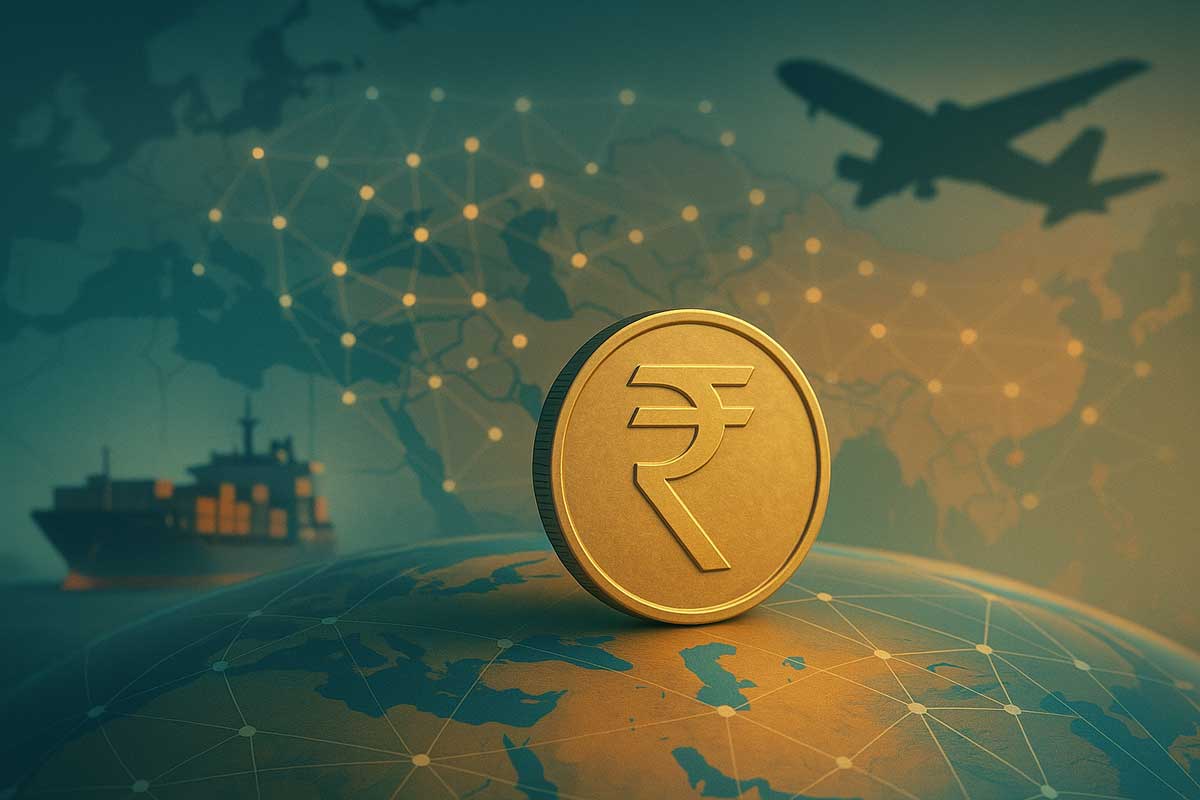
For decades, cross-border commerce relied overwhelmingly on the U.S. dollar. That center of gravity isn’t vanishing—but it is loosening. Within this diversification, India is carving a pragmatic path: promote local-currency trade (especially INR), add new “rails” for moving money, and participate in BRICS discussions on alternative payment mechanisms—without endorsing a single anti-dollar crusade or a shared BRICS currency.
2) What India has already changed
2.1 Rupee invoicing & Special Rupee Vostro Accounts (SRVAs)
Since 2022, RBI’s rupee-settlement window lets foreign banks open SRVAs with Indian banks so exporters/importers can invoice and settle in INR. Recent tweaks simplify SRVA opening and allow SRVA balances to be invested in Government of India securities—improving the utility of accumulated rupees.
2.2 Local-currency settlement (LCS) with key partners
The India–UAE LCS framework (paired with fast-payment linkages) is a model: it trims FX intermediation, shortens settlement, and lowers friction for energy and non-oil trade. Similar corridors are being explored with other strategic partners.
2.3 The Russia test case
Sanctions rerouted flows and made INR settlement attractive, but rupee pile-ups emerged due to trade imbalances. Letting partners deploy SRVA surpluses into G-secs is designed to unlock those balances and stabilise the corridor.
3) BRICS payments: what is (and isn’t) on the table
BRICS finance ministries and central banks are studying local currencies, payment instruments and platforms—including a sanctions-resilient cross-border network. India supports interoperability and optionality, not a common currency. The guiding principle: practical rails that use national currencies and complement, not necessarily replace, existing systems.
4) Why this tilt favors India
4.1 FX savings & pricing power
Settling energy, commodities and inputs in INR or partner LCs saves conversion costs and avoids USD liquidity squeezes during crises. LCS agreements and SRVAs let Indian buyers lock pricing and reduce basis-point leakage.
4.2 Sanction-resilience
Alternative rails reduce single-point fragility. If SWIFT/USD channels are impaired, INR/LC corridors keep essential flows moving (food, energy, pharma).
4.3 Demand creation for Indian assets
Allowing SRVA surpluses into G-secs provides a yield-bearing sink for rupees, deepening rupee markets and supporting sovereign demand.
4.4 Wider export reach for MSMEs
INR invoicing plus instant-payment linkages create a lower-friction on-ramp for MSME exporters who struggle with dollar working-capital cycles.
4.5 Strategic hedging
Maintaining multiple rails—USD/SWIFT + INR corridors + regional instant links + potential BRICS messaging—hedges systemic risk and boosts bargaining power.
5) How this challenges U.S. leverage
- Sanctions reach: Non-dollar rails can narrow extraterritorial leverage in certain corridors.
- Funding dynamics: If invoicing migrates to local currencies, marginal demand for USD balances/Treasuries erodes at the edges—more of a slow burn than a shock.
- Network effects: The rise of LCS, SRVAs, RMB/CIPS, and potential BRICS rails chips away at the default “must-use USD” assumption for specific trades.
The U.S. retains deep capital markets and liquidity advantages. But policy unpredictability and sustained sanctions use have prompted many countries to diversify—nudging the system toward pluralism.
6) The hard parts India must solve
6.1 Convertibility constraint
INR is not fully capital-convertible—prudent for stability, but it limits internationalisation. Partners will keep asking: what can they do with rupees earned? Expanding INR asset menus will be key.
6.2 Trade imbalances
Where partners export more to India, INR surpluses pile up. Solutions include balanced procurement, INR recycling products, and swap lines/guarantees to build confidence.
6.3 Trust & transparency
Global corporates and banks need first-rate compliance standards and dispute resolution. RBI’s simplifications help; consistent, predictable rule-of-law optics matter too.
6.4 BRICS choreography
Shape any BRICS rail to ensure open standards, ISO 20022-compatibility, robust cyber-security, and zero coercion around currency choice.
7) Scenarios: the next 3–5 years
- “Many rails” becomes normal: USD/SWIFT stays central; INR LCS corridors and BRICS messaging pilots gain traction for selected flows.
- Data accumulates: Reserve diversification inches up at the margin; INR appears more in regional invoices where India is a primary buyer.
- Plumbing deepens: More LCS MoUs, instant-payment linkages, SRVA investment options, FX swaps/guarantees for INR trade finance.
- Prudent BRICS role: India supports standards and pilots but keeps latitude to opt in/out per national interest.
8) Policy recommendations for India
- Build demand for INR abroad: Gradually widen SRVA asset menus (beyond G-secs) with clear prudential rules; EXIM Bank INR credit lines; FX-swap backstops for priority partners.
- Scale priority corridors: Energy and food deals in INR/partner LCs where feasible, paired with long-term supply contracts.
- Empower MSMEs: Self-billing and dynamic discounting in INR; UPI-style instant settlement for small exporters; AI-assisted compliance.
- Shape BRICS rails: Open APIs, mutual supervision, data-protection; reject currency pooling or opaque ledgers India cannot audit.
- Keep credibility high: Macro stability, deeper bond-market liquidity, faster contract enforcement—these raise INR’s external utility.
9) Bottom line
This is not a binary world of “dollar vs. anti-dollar.” It’s a multi-rail world where India is adding options—INR settlement, local-currency corridors, interoperable payment systems, and selective BRICS engagement—to reduce vulnerability and cut costs without burning bridges to the dollar system. The advantages for India are tangible; the constraints are real but solvable with thoughtful policy and credible execution.
References:
- RBI: Rupee trade settlement circular & FAQs; Aug-2025 SRVA investment tweak; simplification of SRVA opening.
- India–UAE: 2023 MoUs on local-currency settlement and payment linkages.
- India’s stance: De-dollarisation “not our agenda”; focus on local currencies.
- BRICS payments: Mandate to explore local currencies & platforms; Russia’s BRICS Bridge/Pay concept. MEA India Ledger Insights
- Reserves /payments data: IMF/COFER; Fed 2025 note on dollar shares; SWIFT RMB Tracker.